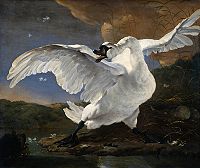
Jan Asselijn
Encyclopedia
Biography
Asselijn was born at DieppeDieppe, Seine-Maritime
Dieppe is a commune in the Seine-Maritime department in France. In 1999, the population of the whole Dieppe urban area was 81,419.A port on the English Channel, famous for its scallops, and with a regular ferry service from the Gare Maritime to Newhaven in England, Dieppe also has a popular pebbled...
. He received instruction from Esaias van de Velde
Esaias van de Velde
Esaias van de Velde was a Dutch landscape painter.-Biography:Born in Amsterdam, where his Flemish father Hans had fled as a Protestant in 1585, he probably studied under his father and Gillis van Coninxloo, a landscape painter from Antwerp and a follower of Pieter Brueghel the Elder...
(1587–1630), and distinguished himself particularly in landscape
Landscape
Landscape comprises the visible features of an area of land, including the physical elements of landforms such as mountains, hills, water bodies such as rivers, lakes, ponds and the sea, living elements of land cover including indigenous vegetation, human elements including different forms of...
and animal painting, though his historical works and battle pieces are also admired. He traveled in France
France
The French Republic , The French Republic , The French Republic , (commonly known as France , is a unitary semi-presidential republic in Western Europe with several overseas territories and islands located on other continents and in the Indian, Pacific, and Atlantic oceans. Metropolitan France...
and Italy
Italy
Italy , officially the Italian Republic languages]] under the European Charter for Regional or Minority Languages. In each of these, Italy's official name is as follows:;;;;;;;;), is a unitary parliamentary republic in South-Central Europe. To the north it borders France, Switzerland, Austria and...
, and modeled his style after Bamboccio (Pieter van Laer
Pieter van Laer
Pieter van Laer was a Dutch Golden Age painter of genre scenes, active for over a decade in Rome, where his nickname was Il Bamboccio...
), also a member of the Bentvueghels
Bentvueghels
The Bentvueghels were a society of mostly Dutch and Flemish artists active in Rome from about 1620 to 1720. They are also known as the Schildersbent .-Activities:...
. Nicolaes de Helt Stockade
Nicolaes de Helt Stockade
-Biography:According to Houbraken, Joost van den Vondel made a poem about him.According to the RKD he became a master in the Antwerp Guild of Saint Luke in 1646 and worked on the city hall of Nijmegen and the Amsterdam City Hall.-References:...
and Asselijn married two sisters in Lyons
Lyon
Lyon , is a city in east-central France in the Rhône-Alpes region, situated between Paris and Marseille. Lyon is located at from Paris, from Marseille, from Geneva, from Turin, and from Barcelona. The residents of the city are called Lyonnais....
in 1645, both daughters of Houwaart Koorman of Antwerp. According to Houbraken, he heard this story from Abraham Genoels, who in turn heard it from Laurens Frank, an artist who was staying in the Koorman household with Artus Quellinus
Artus Quellinus
Artus Quellinus also known as Artus Quellijn, Artus I Quellinus or Artus Quellinus the Elder , was a Flemish sculptor.-Life:...
in Lyons at the time. Their marriages brought both Asselijn and Helt-Stockade back to the Netherlands after their travels. Asselijn had a withered hand and was small of stature, which gave him the nickname in France of petit Jean Hollandois, and which gave him the nickname Krabbetje (little claw) in the Bentvueghels
Bentvueghels
The Bentvueghels were a society of mostly Dutch and Flemish artists active in Rome from about 1620 to 1720. They are also known as the Schildersbent .-Activities:...
.
He seems to have befriended Rembrandt. In the etching that Rembrandt made of him, Asselijn appears in some states to be standing before an easel. His hands are not shown. Frederick de Moucheron, another Italianate landscape painter, was his pupil.
He was one of the first Dutch painters who introduced a fresh and clear manner of painting landscapes in the style of Claude Lorraine, and his example was speedily followed by other artists. Asselijn's pictures were in high estimation at Amsterdam, and several of them are in the museums of that city. Twenty-four, painted in Italy, were engraved.

Johan de Witt
Johan de Witt, heer van Zuid- en Noord-Linschoten, Snelrewaard, Hekendorp and IJsselveere was a key figure in Dutch politics in the mid 17th century, when its flourishing sea trade in a period of globalization made the United Provinces a leading European power during the Dutch Golden Age...
. Several inscriptions were added by later owners of the painting, including "Holland" on one of the eggs, and "Enemy of the state" next to the dog that is threatening the nest. Some parts of the painting are less realistic than the swan, such as the low-hanging clouds, the dog and the flat-looking eggs. The painting has been dated to the 1640s. It is considered to be Asselijn's most famous work and was the Rijksmuseum’s first acquisition.
Willem Schellinks' City Wall in the Winter was long thought to be Asselijn's, until the painting was restored and the original monogram was revealed.

